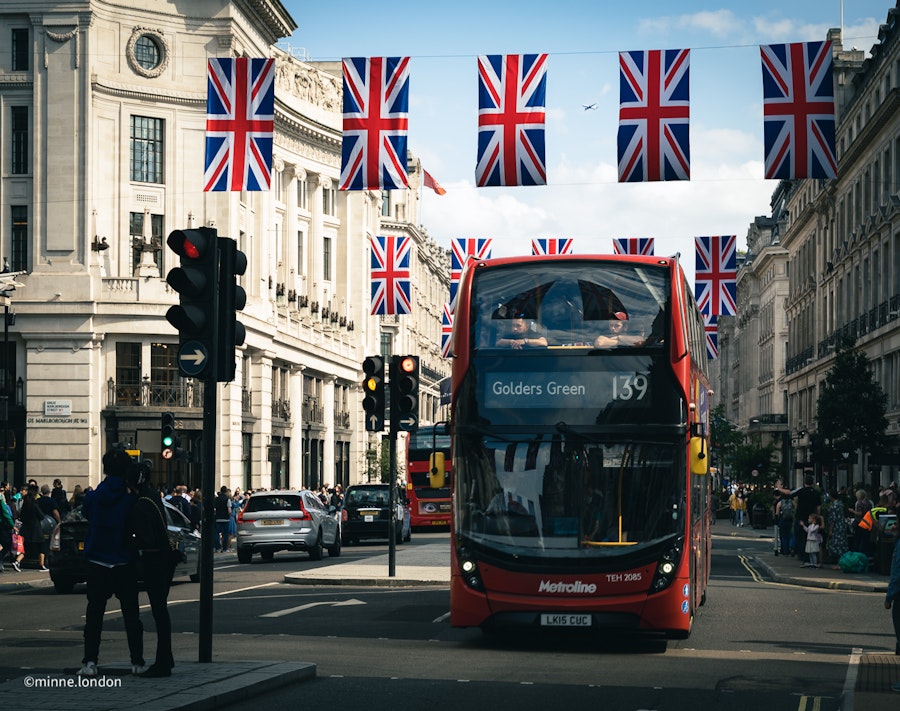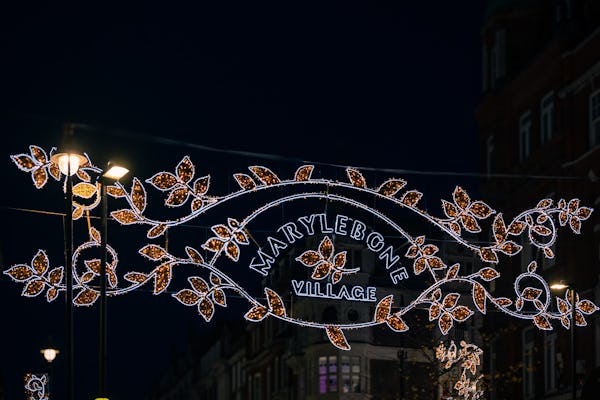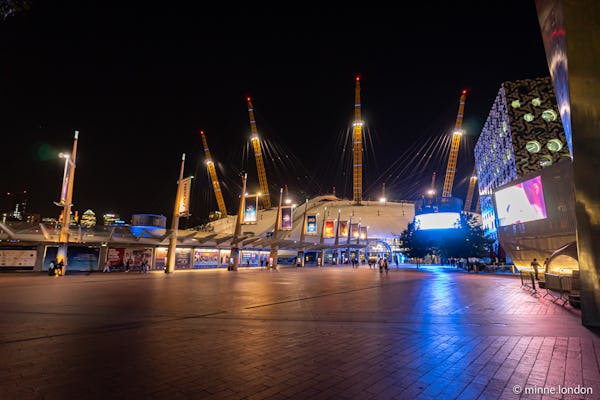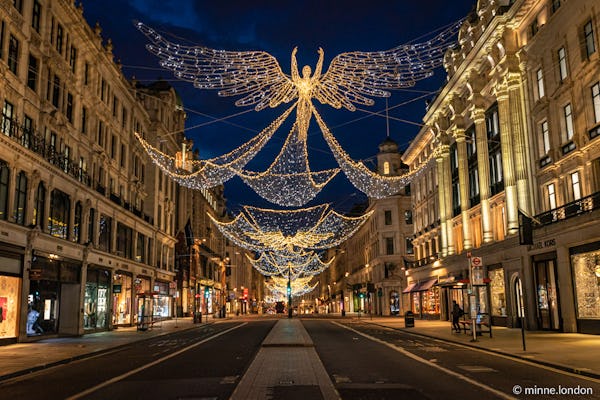
Taking the bus
Travelling around London by bus is an efficient and cost-effective way to get from one place to another. Whether you are a local or visiting the city, taking the bus can be an excellent option for exploring the city's attractions and getting around quickly. With affordable fares, convenient routes, and night buses available throughout the city, London's bus system offers passengers an easy way to get from A to B. An additional advantage is that night buses cover most of the city, while night tube is limited to specific lines. The night buses have an "N" in front of the usual line number.
An essential thing to know about buses in London is that you can't buy a ticket on the bus but must have an acceptable payment method beforehand. Most people use contactless payment, be it a debit card or a mobile phone, while others use an Oyster card.
Bus stops have signs showing which buses stop on them, and it's best to signal the driver that you want to get on. How to enter the bus depends on the bus type. For example, most buses going outside Central London have an entrance only in the front, while in Central London, there are also buses that you can enter from the back. When entering a bus, you'll need to tap in with your payment method, but you don't need to tap out, as the bus fare is always the same regardless of the trip distance.
The bus fare is £1.75 per trip, and there's no extra fee if you switch to another bus in 60 minutes (Hopper fare). The daily cap is £5.25 regardless of how many trips you've done. Children up to 10 years travel free.
Using the Underground (London's subway system)
The London Underground is one of the most popular ways to get around London. It's fast, efficient and relatively cheap compared to other forms of public transport. The Tube network consists of 11 lines that run through 270 stations across Greater London and beyond. Night services are also available on some lines, making it an excellent option for late-night travel. To use the Underground, you'll need a contactless payment card or an Oyster card, which can be purchased at any station ticket office or online in advance. Once you have your ticket, you must find your nearest station and follow the signs to board the train.
The underground system is so vast that even the map can look confusing. Each tube line on the map has a specific colour, and the same colours are used when you get to a station to make getting to the platforms easier. You'll need an underground map or a map application on your phone to know which line to take to get to your destination. Once you know which line to take and what is the closest station, follow the signs inside of the stations to get the platform for the correct line. Once you enter the platform level, a sign on the wall shows all stations on the line for both directions. You'll need to check whether your stop is in the East/West or North/South direction and then choose the right side. Once the journey starts, pay attention to the map on the ceiling and the announcements before stopping at stations. Some stations can get very busy, and you'll need to follow the people out before new passengers start getting on the train. Once out of the train, again follow the signs to exit the station. Most stations have multiple exists, and the best way to exit the station towards your destination is to check the markings at the station.
The price of the journey is based on which zones the trip is made. For example, central London is in Zone 1 and is relatively cheap.
Using the Docklands Light Railway (DLR)
The Docklands Light Railway (DLR) is a light rail system in London that serves several city areas. It is relatively new and well maintained and pleasant to travel in. DLR trains don't have a driver in front of the train, and you can find a scenic seat in front. However, the train does have personnel moving around the carriages and looking after the train journey. The DLR provides frequent service, with trains running daily every few minutes.
DLR serves mainly East and South East of London and reaches Bank and Tower Gateway stations (close to the Tower of London and Tower Bridge) as the west-most stations. It's an efficient and cost-effective way to travel around London, with tickets available at all DLR stations or online. Oyster and contactless cards are accepted as in all public transport in London.
Taking the Overground (London's suburban rail network)
The Overground is a network of rail services in London that operate above ground, as opposed to the Underground, which operates mostly below ground. The Overground serves a variety of destinations in and around London, including areas not served by the Underground. As a result, it can be a convenient way to travel within the city, particularly if you are going to a destination that is not accessible by the Underground. The Overground serves more than 100 stations around the capital. Here are some stations served by the Overground that you may want to visit when visiting London: Wembley/Wembley Arena (Wembley Central) for football or concerts Kew Gardens, home to the famous Royal Botanic Gardens Richmond, a lovely area along the river Thames and the home of Ted Lasso Stratford for a Westfield shopping mall and the Olympic Park
The trains are spacious, air-conditioned, and an excellent way to travel if they serve the route you're after. Tickets work the same way as underground and other rail services, and it's best to use a contactless or Oyster card for travelling. The ticket price depends on the zone you are travelling from/to and can be higher than on other services as the Overground serves zones up to 9.
Using taxis
There are several types of taxi services available in London. However, the ones most people associate with London are the traditional black cabs. They can be hailed on the street, at designated taxi ranks, or using the Gett app. In addition, many black cabs are electric these days, for example, "Electric London Taxis", if you need to book a trip in advance. Black cabs accept card and contactless payments.
Black cab drivers must pass a test to ensure they know about London's streets and landmarks. The cabs are spacious and easy to get into due to their height, even with luggage. There's good seating space available, with usually three seats in the back with foldable seats opposite them if there are more passengers. Black cabs are more expensive than other taxi options but are worth the price as a convenient and reliable way to get around the city. One thing to look out for is the traffic situation. The meter will keep running even when stuck in traffic; if the traffic situation looks bad, you may consider getting the tube instead.
The second option is the ride-hailing apps, for example, Uber and Kapten. These are usually less expensive and conveniently booked from their respective mobile apps, with the price known when booking. You'll need to look out for surge pricing, as the price can increase with more demand.
The third option is private hire vehicles, including minicabs. These must be booked in advance and cannot be hailed on the street like black cabs. However, these might not be as readily available in all city areas. Private hire vehicle drivers should have a license showing that the driver is a "Licensed London Private Hire Driver".
Renting a car
Renting a car is only recommended if you travel outside the city, for example, for a day trip with several people. Train tickets can get expensive when four people travel one or several hours from London.
London is a very busy city, and traffic can be heavy, particularly during rush hour. In addition, driving in London can be stressful, and it can take a long time to get from one place to another. Another problem is finding a parking space. Parking in London can be difficult and expensive, and many areas have limited parking options, particularly in central London. Furthermore, there is a congestion charge of £15 when driving to Central London. Also, did we mention driving on the left side of the road?
Using bicycles
Cycling can be a great way to move around London should the weather allow it. Bicycles are available for short-term rentals in many places around Central London; Santander Cycle has around 800 docking stations across London. You'll find these, for example, in Hyde Park, Kensington Gardens and Green Park. While there are docking stations in many areas, parks are some of the best places to use them as long as following paths where cycling is allowed as it's safe and an excellent way to get from point A to B. Distances are pretty long in places like Hyde Park.
The downside of cycling is that the traffic in Central London can be hectic, and it is scary to ride next to double-decker buses.
Renting a bicycle from a docking station is easy, and the price for a standard bike is £1.65 per 30 minutes. There are also e-bikes available for registered users, priced at £3.30 per 30 minutes. Payment can be made in the Santander app or using a debit/credit card at a terminal next to the docking station. You can return the bicycle to the same or a different docking station when you've done cycling.
One specific place where cycling is the thing to do is Richmond Park. Cycle hire is available in the park, not via Santander Cycle but ones specific for Richmond Park. In addition, there are cycling paths available around the park, ranging from 5 to 17 kilometres, where you can enjoy the landscapes and see wild deer living in the park. Richmond Park is a popular cycling destination when the weather is nice.
Using the Uber Boats by Thames Clippers river bus service

One exciting way to travel in London, combining getting to a destination to seeing some sights, is by using the Thames Clippers river bus. Thames Clippers has many stops along the Thames, from Royal Arsenal in Woolwich in the east to Putney in the west. It offers the utility of getting around and a new perspective on many sights along the Thames. There are stops in many popular locations, for example:
- Embankment for Big Ben and Houses of Parliament
- London Eye
- Tower for Tower of London and Tower Bridge
- North Greenwich for O2
- Battersea Power Station
To travel, you can use a contactless or Oyster card or purchase a ticket in advance on the Thames Clippers website or using the Thames Clippers Tickets app or the Uber app. A single adult ticket price depends on the zone you're travelling from/to. There are three zones, West, Central and East Zones. The price for an adult inside a zone is £8.60 and gets more expensive when travelling across zones.
However, if you want to visit more locations along the Thames, getting a River Roamer ticket is an excellent option, allowing unlimited all-day travel across all piers. The price for an adult is £21.20 and for a child £10.60. There's also a Family River Roamer available ticket for £42.40 (2 adults + up to 3 children (5-15)).
The boats even have a cafe/bar for drinks and snacks. Thames Clippers really is a lovely way to travel, especially on a nice summer day.
Conclusion
As you see, there are several ways to travel around London. Each of these has its own benefits and use cases. Most of the time, using the Underground and buses is enough, but using other means of transport can bring something extra to the trip.






